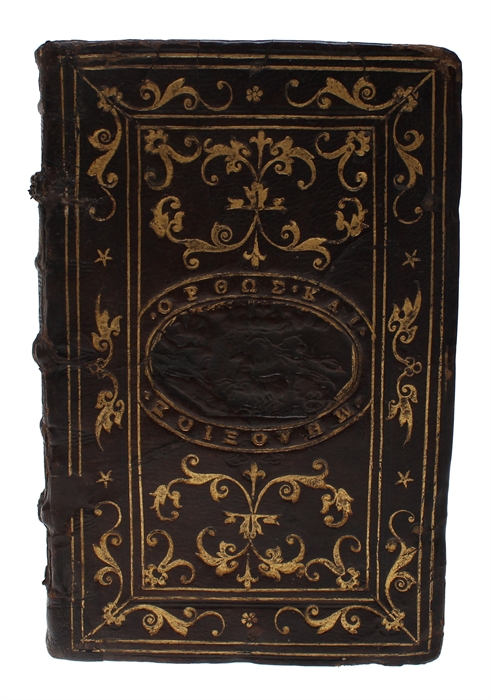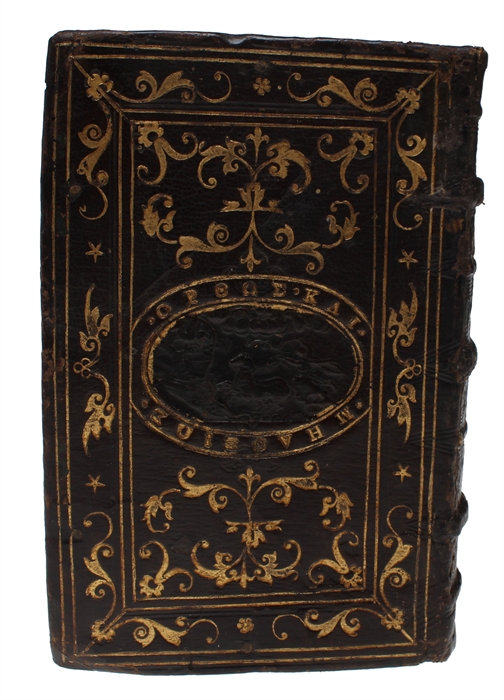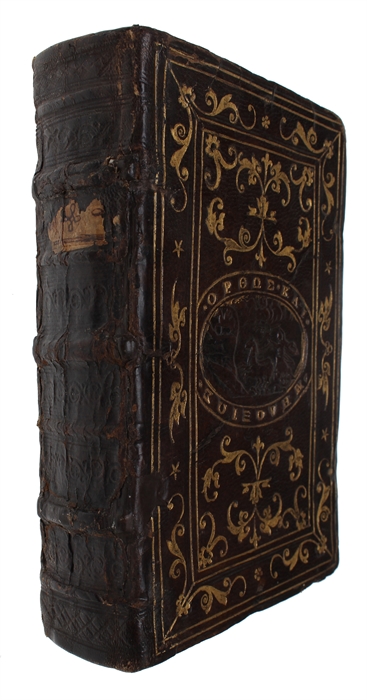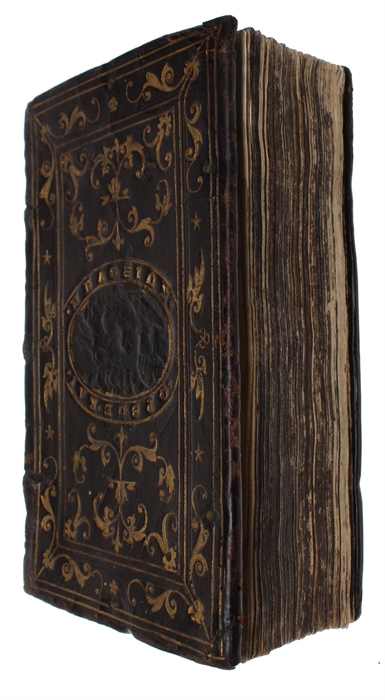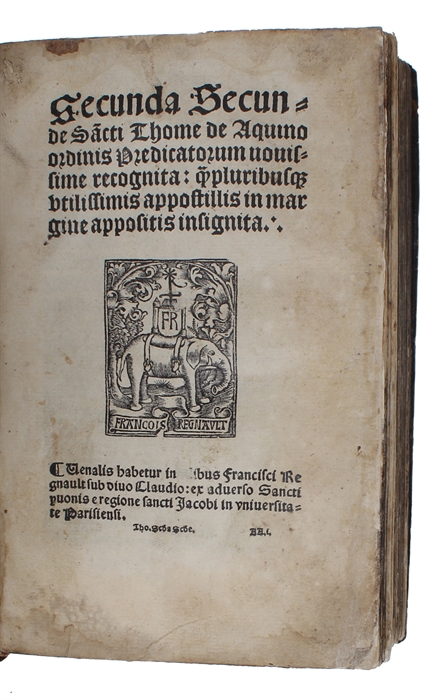ONE OF THE FAMOUS PSEUDO-CANEVARI-BINDINGS
THOMAS AQUINAS.
Secunda Secunde. Novissime recognita.
Paris, Francois Regnault, (1520).
8vo. Bound in a splendid contemporary full goatskin binding with raised bands to richly blindstamped spine. Remains of paper title-label to spine. Boards with blindstamped double line-borders and oval kamé-centre-pieces with the famous Apollo and Pegasus. The clouds are in relief, the wheel of the carriage has four spokes, Apollo's clothing covers almost the entire body, the front of the whip is above the head of the horses, and the top front leg of the horse is close to straight. Boards covered in rich ornamental gilding and with gilt Greek lettering around the kamés. Neat professional restoration to spine and hinges and renewed cords.
A lovely contemporary full goat binding from Venice with later elaborate ornamentation over the original.
First and last leaves with a bit of soiling and brownspotting. (16), 396 ff. With the woodcut printer's device of Regnault to title-page and verso of final leaf.
A lovely copy of one of the so-called pseudo-Canevari-bindings. In the 1870'ies, the name Demetrio Canevari started appearing in connection with a certain style of Renaissance bindings that all contained books printed before 1520, many from the 1540'ies. They all have certain traits in common: olive green or brown or dark red morocco, a certain type of gilding and an oval centre-piece depicting Apollo in his chariot and Pegasus on a cliff. In the 1930'ies, about 90 volumes of these bindings were known and they were all paid for with extremely high prices. Demetrio Canevari was born in 1559 and became the life doctor of Pope Urban VII. He ammassed a library of 5.000 volumes and died in Rome in 1625. The Jesuits ended up inheriting most of the remaining library in 1844, and by 1891, two librarian could conclude that there were 2.000 volumes left. Amongst those 2.000 volumes, there was not a single one bound in what we now call the Canevari-style. How they have come to be detremined as such has been somewhat of a mystery. But at the beginning of the 20th century, the mystery was solved by the librarian and professor Fumagalli - the alleged provenance of the bindings was simply made up by a daring antiquarian bookseller, who was also a book thief, the famous Count Libri Carrucci. He invented a provenance and a story for what he wanted to sell. In his catalogue from 1859, he had three books with the Apollo-centrepiece, all described with an unknown provenance. In his catalogue from 1862, these bindings were now described as coming from either Mecenate or Demetrio Canevari. This was quickly picked up by other antiquarian booksellers, and by 1883, Quaritch announced that these bindings presumably came from Demetrio Canevari's father Mecenate. It soon became a stable fact in the book world that these poetic bindings wth the "super ex-libris" came from Canevari's collection. They became a matter of mythical status and the Canevari-bindings were mentioned with the same awe at the collections of kings and popes. These magnificent bindings stamped with the distinctive Apollo and Pegasus medallion were thus celebrated long before their original Renaissance owner was correctly identified, namely as Genoese Giovanni Battista Grimaldi. This also opened the path for a highly skilled book-binder to make forgeries that would long be misten for originals. It turned out, as Fumagalli woud unravel, that a bookseller (M.) and a book binder (Villa) had set up a business together forging old book bindings, among them the so-called Canevari-bindings. Several dealers, among them Quaritch in London, bought these, not knowing they were forgeries, and sold them on. The crave for so-called Canevari-bindings did not die, however, and even the forgeries are now highly sought after. Due to extensive research, they are now fairly easy to distinguish from the originals (that still have nothing to do with Canevari) as they vary in size and stamping manner, but are still of very high quality and are utterly charming. The myth surrounding these magnificent bindings make them even more desired, as they occupy a central place in the history of book binding and book collection. The original Canevari-bindings are extremely rare on the market, as are the forgeries. In all, 144 bindings with the Apollo and Pegasus medaillion have been identified to be original, whereas Wittock 1998 lists 45 falsified ones. These are all of great interest to the serious binding collector. This book is nr. 57 in Fumagalli's register. It has belonged to the director of applied art in Frankfurt, F. Luthmer, who bought it in 1885 in Milan. It was sold in 1921 by David and Orioli in London. In 1922 it featured in Ernst Fischer: The History of the Binding, described as a book from Canevari's library. It is depicted and described as nr. 3. in Anker Kyster's study of fake Canevari-bindings from 1934.
Order-nr.: 60094

